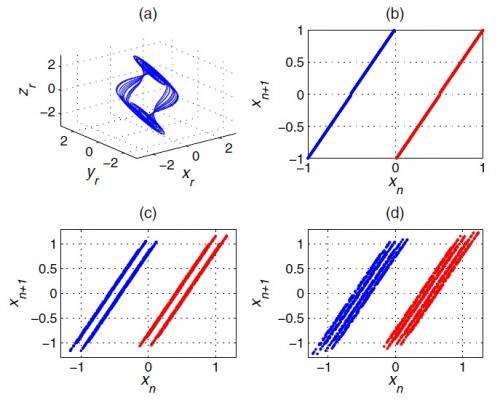Researchers have found that the information transmitted by a chaotic signal in a wireless communication system is not modified by the wireless channel as it is for non-chaotic signals. These figures show reconstructions of wireless signals traveling in different wireless channels. Credit: Hai-Peng Ren, et al. ©2013 American Physical Society
(Phys.org) —In today's wireless communication systems, the wireless signals are non-chaotic, meaning they have a well-defined period and frequency. Non-chaotic wireless signals are used in many applications, such as satellite communications, GPS navigation, cell phones, and Wi-Fi devices. However, as many people know first-hand, wireless systems usually have inferior performance compared to wired systems. The problem is due to physical impediments that the wireless signal faces in open space caused by the atmosphere, water, mountains, buildings, and other different media. Now in a new study, researchers have investigated how wireless communication could be implemented with chaotic signals, and found that chaotic signals could overcome some of these physical constraints and lead to superior performance.
The researchers, Hai-Peng Ren at Xi'an University of Technology in Xi'an, China, and the University of Aberdeen in Aberdeen, UK; Murilo S. Baptista at the University of Aberdeen; and Celso Grebogi at Freiburg University in Freiburg, Germany, have published their paper on wireless communication with chaos in a recent issue of Physical Review Letters.
Although this is the first time that researchers have investigated how chaotic signals can be used in a wireless communication system, there has been a large amount of research on using chaotic signals in wired communication systems. The use of chaos in communication systems is appealing due to several intrinsic properties of chaos and the fact that chaotic signals can be generated by low-power, low-cost, small-area electronic circuits.
"A chaotic signal is generated by a non-linear system that has sensitivity dependence on initial conditions," Baptista, on behalf of his coauthors, told Phys.org. "Small perturbations in the system at a given time produce large changes at a later time—a property that is measured by the Lyapunov exponent. A chaotic signal has at least one positive Lyapunov exponent (two nearby initial conditions diverge exponentially fast from each other), but also negative ones. A chaotic signal is also aperiodic and broadband (it processes infinitely many frequencies). This last property is the consequence of the fact that a chaotic trajectory stays very close to an infinite set of periodic signals of infinitely many periods.
"A non-chaotic signal, such as a periodic one, is characterized by having a well-defined period (it always returns after completing one period; it is not aperiodic), it is generated by a system that does not have sensitivity to initial conditions, and it has only one well-defined frequency (not broadband)."
Scientists have previously shown that chaotic signals in wired communication systems can achieve higher bit rates (resulting in faster information transmission) in a commercial wired fiber-optic channel compared with non-chaotic signals.
In the new paper, the scientists' main result is that, although a chaotic signal itself is strongly modified by the wireless physical media through which it propagates, the information transmitted by the signal is not modified. That is, the information remains exactly the same when it is picked up at the receiver as it was when it was sent by the transmitter, despite having traveled through open space.
The researchers attribute this finding to the fact that chaotic signals preserve their spectra of positive Lyapunov exponents after being transmitted through wireless channels. The researchers also calculated that the amount of information in a transmitted chaotic signal is equal to its positive Lyapunov exponent, allowing them to determine a chaotic signal's information capacity.
"The fact that the positive Lyapunov exponent(s) of any chaotic signal is (are) preserved in the wireless channel means that the information transmitted arrives to the receiver and is available to be 'collected' (decoded)," Baptista said. "Decoding is possible because the negative Lyapunov exponents are also preserved, and allow us to use chaotic signals that, despite being modified, preserve their topological form (dimension)."
This capability of chaotic signals to propagate through open space while preserving their information is very different from the behavior of non-chaotic signals, where both the signal and the information it carries are modified by the physical media. One of the biggest causes of modification is multipath propagation, which occurs when a signal is disrupted so that it travels along many different paths and arrives many times at the receiving location. Interference and noise occur as a result, preventing information from being transmitted at a high bit rate. Multipath propagation is caused by reflection and refraction from the atmosphere, water, and terrestrial objects.
As the researchers explain, wireless chaotic signals are not affected by multipath effects. This is because a chaotic signal that is used to communicate wirelessly has an information capacity (the amount of information per unit of time) that depends on the Lyapunov exponents of the signal—which is a property of the chaotic signal itself—but does not depend on the properties of the physical wireless channel, i.e., the multipath. It is as if multipath does not exist in the wireless channel. On the other hand, the amount of information per unit of time that can be transmitted wirelessly using non-chaotic signals depends on the properties of the multipath. As a result, chaos provides a natural way to create high-capacity communication systems.
The researchers are currently developing a prototype chaos-based wireless communication system based on the ability of wireless chaotic signals to preserve their Lyapunov exponents after transmission. They predict that it will possible to develop a large-scale chaos-based wireless communication system that would have excellent performance by overcoming the interference and noise that negatively affect today's non-chaotic wireless signals.
More information: Hai-Peng Ren, et al. "Wireless Communication with Chaos." PRL 110, 184101 (2013). DOI: 10.1103/PhysRevLett.110.184101
Journal information: Physical Review Letters
© 2013 Phys.org. All rights reserved.




















